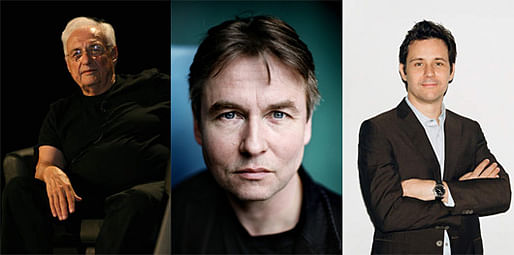

To celebrate Disney Hall’s tenth anniversary, architect Frank Gehry and Conductor Laureate for the Los Angeles Philharmonic Esa-Pekka Salonen reminisced on the building’s inspiration last night, at a discussion held at the Hammer Museum. Co-hosted by the LA Phil, far from the actual concert hall and its spotty downtown L.A. environs, the discussion’s moderator Nicolai Ouroussoff (former architecture critic for the New York Times) tried to tease out the relationship between architecture and music. While Salonen touched upon questions of classical music’s relevance, Gehry didn’t delve too deeply into the particulars of his design.
As Music Director for the LA Philharmonic from 1992-2009, Salonen oversaw the orchestra during its transition from the slightly-stuffy Dorothy Chandler Pavilion over to Disney Hall, and is highly regarded for whipping the Philharmonic into shape as a progressive and formidable cultural institution. The trajectory of the LA Phil is largely wrapped up in both Salonen and Gehry’s ambitions for the Hall and classical music in general -- that they should be more democratic, and offer a tangibly emotive experience.
The goal of Disney Hall, according to Salonen, was to “shake the dust off of architecture and classical music,” while Gehry imagined an “infinitely democratic room” that would create intimacy between audience and performers -- where there were no bad seats, and everyone was treated equally. An outright utopian vision for Grand Avenue to be sure, which at the Hall's opening nowhere near resembled the iconic civic boulevards of cultural epicenters like New York City or Paris.

To Gehry though, this lack of atmosphere at the Hall’s site was liberating; there was nothing to emulate, no architectural consistency to respond to. There were certainly things Gehry sought to avoid associating with -- the Dorothy Chandler Pavilion, for instance -- but it was also extremely important that the Hall be received as part of the city and streetscape. Great care was taken to configure the Hall’s gigantic scale in a way that opened to both pedestrians and drivers (which, in LA, was a high enough priority to spend $110 million on the Hall’s underground parking garage*, accounting for nearly 46% of the total costs).
Both Salonen and Gehry, while collaborating on the Hall's design after Lillian Disney’s initial seed gift of $50 million, wanted to convey a more integrative approach to orchestral music. To Salonen, classical music risks irrelevance only when played badly and too quietly -- it should be a part of contemporary life, something pop music manages to do by creating physical and emotive live performances. Gehry’s design echoes this desired volume with its wrap-around seating, and an exterior that’s recognizable miles away, while still legible and evocative up close. And on a more immediate level, the Hall’s acoustic are vastly superior to the Dorothy Chandler Pavilion, the LA Phil’s previous home.
Succeeded by Venezuelan conductor Gustavo Dudamel, Salonen’s momentum with the LA Phil continues, supported by the performative strength of the Hall and its evolving surroundings -- Eli Broad’s contemporary art museum will open late 2014, another civic structure added to downtown LA’s rapidly complicating landscape. While the discussion was relatively sleepy, it succeeded in rearranging the priorities of architectural discourse, putting program at the forefront of the discussion, urban impact second, and form at the end.
No Comments
Block this user
Are you sure you want to block this user and hide all related comments throughout the site?
Archinect
This is your first comment on Archinect. Your comment will be visible once approved.